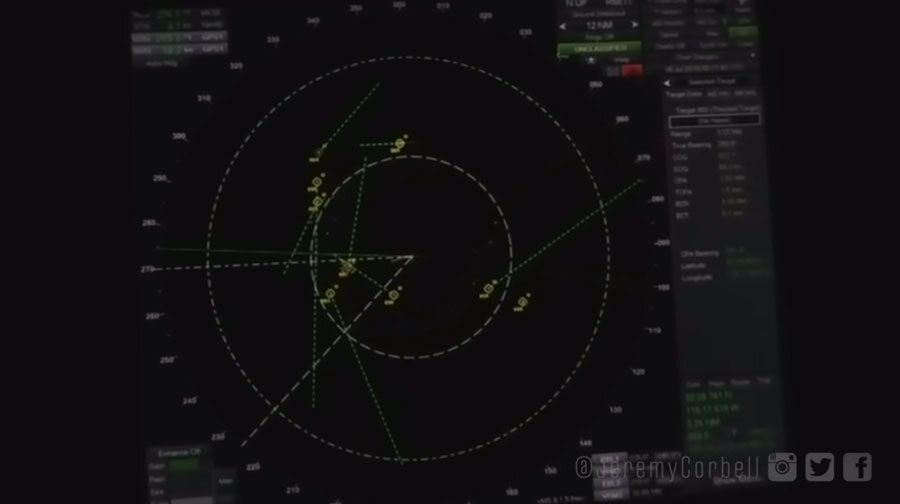USS Omaha Encounter: Further Revelations
“Officer of the Deck, if you can write a general Lat/Long of where we’re at?”
THIS WAS THE start of footage showing an extraordinary set of events apparently captured by a Visual Information Personnel (VIPER) Team onboard the US Navy’s Littoral Combat Ship USS Omaha (LCS-12) on the late evening of 15th July 2019. It was shot at roughly the same time that the previously-released footage of the spherical-shaped object entering the water was taken, and also on the same date and from the same vessel. Omaha was in the approximate position 32°29’21.9”N, 119°21’53.0 W, which puts her and the other ships in the group in a training area around 110 miles off San Diego.
As per the previous release from onboard Omaha, this unclassified footage seems to have been taken by a mobile phone, and in this case data along the right hand side of the screen has been blurred, presumably due to its sensitive or secret nature. There are also three “jump cuts”, where whole sections of video have been cut out. This may have been due to security issues, but the exact reason Whilst an overall lack of context has been criticised by some commentators since its release, the footage of the radar screen and its associated soundtrack is a further piece of information added to the overall whole, and appears to be unprecedented, at least in regard to recent events.
Two separate radar systems were employed to track the targets. The first was a sea search radar, which as the name implies is designed to locate objects on the water. As such, it has an effective range of up to about seventeen miles, which is the distance to the horizon from the elevated section of the ship where the radar transmitter is located. The second is an air defence radar, which, depending on the type of system used, can track targets at very high altitudes and at some considerable distance. However, if the targets are at or near sea level, the radar’s effective range is limited to not much more than the sea search system.
Despite Omaha being able to track them in the immediate vicinity of the group of US Navy vessels, the nature of these targets was not identified. Nor were their launch and landing points if they were indeed drones. It is unlikely that the objects were misidentified as US Navy jets or helicopters, civilian aircraft, balloons or seabirds. Most aircraft carry transponders and would have showed up as such on the radar display. Identification Friend or Foe (IFF) and Tactical Air Navigation (TACAN) systems are used to trigger responses from transponders – which would provoke a “here I am” type of answer, complete with details of the machine involved. Transponders can fail at times due to technical issues, but it is unlikely that nine or more failed at the same time from a closely knit group of aircraft. Whilst the IFF and TACAN systems are not 100% infallible, they do identify an extremely high proportion of contacts.
“Eyes up. Eyes down.”
I believe this is a reference to systems which acquire further data which is then passed to the vessel’s computerised Fire Control system, responsible for deploying weapons onboard ship. This sensitive equipment is classed as “active” rather than “passive”, as it acquires information rather than “listening out”. Doctrine is therefore to use such systems sparingly and fleetingly, as keeping these switched on allows a potential adversary to learn a great deal about the capabilities of a warship. During the Cold War, both NATO and Russian forces would attempt to force the other side’s land, air and surface air-defence radars to actively acquire their own electronic intelligence (ELINT) gathering platforms using their active search capabilities. Radar “signatures”, unique to each system, can be obtained in this fashion, along with other information useful to a potential aggressor.
There was a request made for the numbers of contacts, plus their courses, speeds and bearings from Omaha. According to the notes accompanying the release by Jeremy Corbell, at least fourteen targets were identified, although the true figure may well have been higher. The maximum number of targets shown on the released footage is nine. Given that they were picked up on radar, it was believed that the objects comprised a solid mass, and that they were in excess of six foot in diameter. They were also classed as “self-illuminated”, meaning in this context that they were lit up rather than “illuminated” by a radar system.
“Track 781 just sped up to 46 knots. 50 knots. Closing in.”
Looking more closely at the display itself and armed with a key of the Naval Tactical Display System symbols used on such equipment, it appears that the targets were represented by diamond-shapes, each with their own track number allocated below.. One interpretation was that the targets were being treated as hostile, although a high degree of caution should be exercised due to the nature of the footage. Everything on the display appeared yellow, although it should be a full-colour image. It was impossible to read the track numbers or accurately confirm the symbols used. From the key to such symbols, there are three separate levels employed: Friendly, Unknown and Hostile. Friendly forces show as blue, Unknowns as yellow and Hostiles as red. However, the targets appeared to be represented by diamonds, which is one of the hostile icons used.
“138 knots. Holy shit. They’re going fast. Oh, it’s turning around.”
“That one’s pretty much perfectly zero zero zero relative, right?”
At one point during the footage, one of the targets is tracked at 138 knots (158 mph) and then turns around. Whilst it’s not entirely clear whether the crewman is referring to the same object, three seconds later on the video, a target is stated as being “zero zero zero”, which in naval parlance means directly ahead of the vessel.
Still images taken from this footage also formed part of the Unidentified Aerial Phenomenon Task Force (UAPTF) intelligence briefing that apparently took place on 1st May 2020. Intelligence reports suggested that the spherical-shaped craft possessed trans-medium capabilities, being able to enter the water without destruction. A US Navy submarine assigned to the group of vessels was ordered to search for underwater contacts or debris from the objects that were observed or tracked heading into the sea, but nothing was found. Whilst this is interesting, it does not necessarily follow that the targets did not break up on impact with the water, just that no wreckage or objects were located.

If sonar was used to track Unidentified Submersible Objects (USOs), then a combination of systems would have been used. The first is passive sonar, which “listens” for the sound made by vessels, either the noise made from propellers (cavitation) fitted to a ship, submarine or torpedo. The last resort is active sonar, where a pulse ( “ping”) is transmitted, bounces off a target and is received, allowing bearing and distance to be calculated. However, passive systems can detect “pinging” at least twice as far away as a passive one can, so it is used infrequently. Whether both passive and active systems, together with any other naval listening equipment located in the area picked up any trace of the underwater movements of these objects is unknown.
There is a question as to whether small combat vessels such as Omaha have a VIPER Team permanently assigned or if this was a special event. Littoral Combat Ships are slightly larger than a corvette (for example a Chinese Navy Type 056), and are about the same size of a Oliver Hazard Perry-class anti-submarine warfare frigate. However, they have slightly less than half of the frigate’s crew complement. With a permanent crew of around 40, plus around35 mission specialists who can be rotated in and out depending on the ship’s assigned role*, it may be that VIPER Teams are made up from personnel carrying out other functions onboard ship.
Does a chain of custody document exist covering this release? If not, was it obtained legally, and how can it be effectively used as evidence when its provenance is questionable? Whilst some demand that those “in the know” leak everything they have, leaked details often come with strings. In this case, the “strings” are a lack of context, as we do not know what events led up to the start of the footage, what actions were taken by the crews onboard the various US Navy vessels and also how the objects departed the scene. Details matter, especially to researchers. Are we simply looking for more cool stuff, or do we want information that stands up to all scrutiny, especially in terms of how it was obtained?
In a bid to obtain an official statement regarding the footage, the Daily Caller’s Alec Sears contacted the Pentagon for a response immediately after the information was made public. After initially replying that they were “looking into it”, spokesperson Susan Gough contacted the reporter to confirm that “the video was taken by Navy personnel, and that the UAPTF included it in their ongoing examinations.” It is interesting to see the speed of response here. It was not that long ago that questions asking about the validity of information took several days, weeks or even months. That timescale has been severely reduced of late, to the point where enquiries are now answered within a matter of hours. Is there a reason for the speedy response? Does the forthcoming evaluation by the Department of Defense’s Office of Inspector General have anything to do with this? We will have to wait and see what transpires.
Meanwhile, commentators, interested citizens, debunkers and the media will no doubt pick the details of the footage apart in an attempt to dig out further information and analyse what limited data exists. One thing is for sure. There is more where this came from. When it will be released, under what circumstances and what it reveals is up for debate. That it will appear at some future stage is not.
*The original function of the Littoral Combat Ship was to have interchangeable “mission modules” to allow the vessels to perform different functions as and when required. However, problems in reconfiguring vessels from one module to another forced the US Navy to abandon these plans and now the three separate divisions of ships will be assigned one role each.

